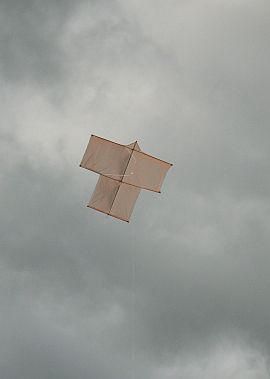- Home Page
- Flight Reports
- Sticked Sodes
MBK Sode Kite Stories
Featuring Sticked MBK Sodes
An MBK sode kite is fun to fly in any size although the smallest one requires a rather long tail for stability. No other other commonly flown "flat" kite has a cambered wing quite like the sode. This makes it very efficient and prone to accelerate here and there in straight lines.
On this site, there's more kite-making info than you can poke a stick at. :-) Want to know the most convenient way of using it all?
The Big MBK E-book Bundle is a collection of downloads—printable PDF files which provide step-by-step instructions for many kites large and small.
That's every kite in every MBK series.
In light breezes the Dowel Sode settles right down and is smooth and predictable like a rok.
Being quite lightly built, the Dowel Sode requires a four-leg bridle
to keep the frame rigid in flight. This is also very handy for trimming
the kite straight by shifting a bridle knot left or right a fraction.
Here's a short-format flight report featuring the Dowel Series kite:
"High in Cold Air"
It was another short but very enjoyable flying session while the small son enjoyed his soccer practice a few blocks away. This time it was the sode's turn to be brought out of mothballs for a fly.
 MBK Dowel Sode
MBK Dowel SodeAfter setting up the wind meter on its tripod and rigging the kite, launching was easy in the gusty breeze coming through between the scattered trees upwind. Out to about 30 meters of line, I just let it slip fast enough to maintain a 40-degree line angle.
Flying about on 60 meters (200 feet) of line, the big sode surged around and quivered occasionally in the rough air. There were no dramas although the line was tight in the almost moderate-strength wind up there.
Then I had a bit of fun, shaking line off the winder with my left hand while controlling the slippage with my right hand. This was done fast enough to allow the kite to sink down to a mere 15 or 20-degree angle, far away on 90 meters (300 feet) of line. Once there, I just hung on while the kite did a magnificent fast climb, weaving gently on its way straight up to 60 degrees.
Not content with a mere 90 meters, I continued to let line out slowly until the Dowel Sode finally sat almost motionless up around an altitude of 350 feet above ground. The breeze was smooth and moderate in strength at that height. The line was pulled tight and sagged by only 5 to 10 degrees.
I can't actually remember ever flying this sode in such smooth air before. There it was today, "nailed to the sky" until I decided to take it down about 10 minutes later.
Passing down through 250 feet, the line tension quite suddenly slackened off—but just a little. Then again, below 50 feet, the line tension decreased further, and the sode started shifting around and quivering in turbulence from the trees and houses upwind.
With the kite on the ground, a quick check of the wind meter showed an average wind speed of just 3.7 kph near ground level and a maximum gust of 12.4 kph. It felt like a steady 15 or 18 kph up high, though!
Tim's Blog Posts
Featuring MBK Sode Kites
Since these are short-format reports, they are grouped together. The first page covers dowel-sparred kites, and the second covers bamboo-skewer kites.
Tim's Flight Reports
Featuring MBK Sode Kites
The links below are full-length reports recorded by me, each featuring an MBK sode kite of one type or another.
Frolicking in Moderate Winds and Thermals (Dowel)
Smooth Stable and Predictable! (Dowel)
Bridle Sorted, 2-Skewer Sode Kite Soars High (2-Skewer)
Gusty Moderate Winds and One Heck of a Thermal (2-Skewer)
High and Stable in a Moderate Breeze (1-Skewer)
The story or stories above document actual flying experiences. My write-ups are definitely "warts and all," since things don't always go totally as planned. However, half the fun of kiting is anticipating the perfect flight. When it happens, it's magic!
As mentioned earlier, there's more kite-making info here than you can poke a stick at. :-)
Want to know the most convenient way of using it all?
The Big MBK E-book Bundle is a collection of downloads—printable PDF files which provide step-by-step instructions for many kites large and small.
That's every kite in every MBK series.
